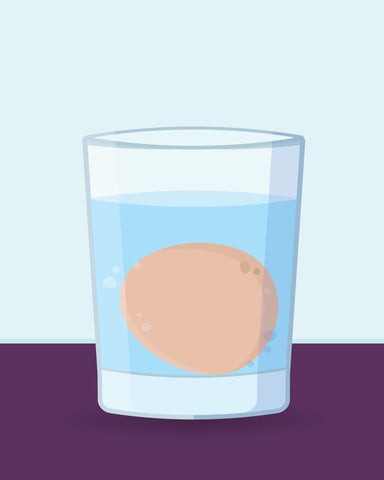Like any fresh food, eggs aren’t designed to last indefinitely. While their shells offer a degree of protection, ensuring you use eggs while they’re still at their best is key for both taste and food safety. Despite processing methods that might slightly reduce their natural protective barrier, eggs still boast a reasonable shelf life. Generally, you can consume eggs for up to 45 days from their processing date, which typically occurs shortly after they are laid. However, if you’re unsure about an egg’s age and want to be certain it’s still good to use, there are several simple methods to help you determine its freshness. Let’s explore how to confidently tell if your eggs are still good to go.
The Water Test for Egg Freshness: A Simple Float or Sink Check
One of the most popular and effective ways to check egg freshness is the water test. It’s quick, easy, and requires only a bowl of water. Here’s how to do it:
Fill a bowl or glass with approximately four inches of cold water. Gently place your egg into the water. Observe what happens.
What the Water Test Reveals:
- Sinking Freshness: If the egg sinks to the bottom and lays flat on its side, you have a very fresh egg. This is ideal for poaching or frying when you want a compact yolk and white.
- Standing but Still Good: If the egg sinks to the bottom but stands upright on its small end, it’s still good to eat, though it’s not as fresh as the sinker. These eggs are perfect for hard-boiling. As they age slightly, the air pocket inside them grows, making them stand up. Interestingly, these “more mature” eggs offer some culinary advantages. They tend to peel more easily after hard-boiling, and the egg whites whip up to greater volumes, which is excellent for baking meringues and other desserts.
- Floating = Time to Toss: If the egg floats to the surface of the water, it indicates that the egg is no longer fresh and should be discarded. As eggs age, the porous shell allows air to enter, creating a larger air pocket. This increased air pocket makes the egg buoyant enough to float.
Beyond the Float Test: Other Ways to Assess Egg Quality
While the water test is a great starting point, there are other sensory checks you can perform to ensure your eggs are safe to eat.
The Smell Test: Trust Your Nose
Your sense of smell is a powerful tool for detecting spoiled food, and eggs are no exception.
- How to Perform the Smell Test: Crack the egg into a clean bowl or dish. Immediately sniff the egg.
- What to Look For: A fresh egg should have very little to no odor. If you detect a pungent, sulfurous, or unpleasant smell, it’s a clear indication that the egg has gone bad and should be thrown away. This foul odor is often a result of bacterial growth inside the egg, especially if the shell has been cracked or damaged, allowing bacteria to penetrate.
Visual Inspection: Look Inside the Egg
After cracking the egg for the smell test, take a close look at its appearance.
- Examine the Shell: Check the inside of the shell for any unusual signs like black or brown spots, which could indicate mold growth.
- Observe the Egg White and Yolk: A fresh egg white should be somewhat thick and gelatinous, and the yolk should be vibrant and stand tall. As eggs age, the egg white tends to become thinner and more watery. While a watery egg white doesn’t automatically mean the egg is bad, it can be a sign of declining freshness.
- Blood Spots vs. Spoilage: Don’t confuse blood spots or meat spots (small red or brown spots) with spoilage. These are natural occurrences and are safe to eat or easily removed with a spoon. They are not an indicator of a bad egg.
Egg White Consistency: How Runny Is Too Runny?
The consistency of the egg white can also give you clues about freshness.
- Fresh Egg Whites: Fresh egg whites are thicker and hold their shape better.
- Runny Egg Whites: As eggs age, the egg white naturally becomes more watery due to air permeating the shell over time. While slightly runny egg whites are not necessarily unsafe, very watery whites, especially in conjunction with an unknown expiration date or other concerning signs, might suggest it’s better to err on the side of caution and get a fresh carton.
By using these simple methods – the water test, smell test, visual inspection, and checking the egg white consistency – you can confidently determine if your eggs are good to eat and avoid any potential food safety issues. Enjoy your eggs with peace of mind, knowing you’ve taken the steps to ensure their freshness!
